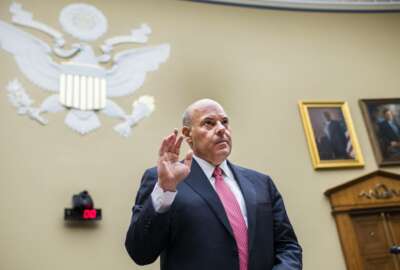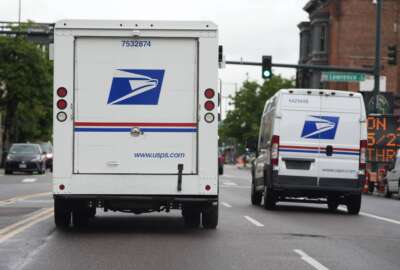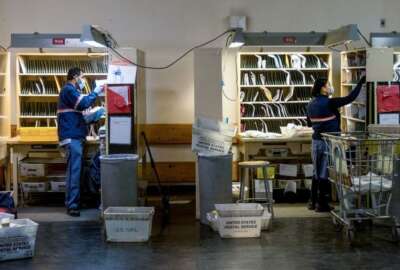
USPS expects to fall short of ‘break even’ goal amid high inflation, employee retirement costs
The Postal Service is falling behind on a plan to reverse its long-term financial losses, citing record inflation and what it calls unsustainable contributions ...
The Postal Service is falling behind on a plan to reverse its long-term financial losses, citing record inflation and what it calls unsustainable contributions to a federal retirement fund that covers some postal retirees.
USPS reported a $56 billion net income for fiscal 2022, ending a 15-year streak of annual net losses. But the sudden reversal of its financial situation is only through short-term relief from a major postal reform bill President Joe Biden signed into law in April.
As for long-term resolutions to its finances, Postmaster General Louis DeJoy told the USPS Board of Governors the agency isn’t expected to reach a financial “break-even” point in fiscal 2023, as expected in the agency’s 10-year reform plan.
“Unfortunately, with all that has been accomplished financially, our 2023 budget will not show the break-even results we were striving for,” DeJoy said Thursday.
Under the “Delivering for America” plan, released in March 2021, USPS expected to start breaking even on its annual finances as soon as 2023, but no later than 2024.
USPS, under this plan, also anticipated fully digging out of its long-term financial hole by 2030, going from $160 billion in projected net losses to a $200 million net profit.
“As I have said before, this means change — a lot of it — and it takes time,” DeJoy said. “With stakeholder cooperation, this will take five years to mostly accomplish. Without stakeholder cooperation, a lot longer.”
DeJoy said plans underway to modernize the USPS delivery network, which includes shifting some letter carrier operations to large, regional Sort and Delivery Centers, would help the agency increase revenue, cut operating costs and reduce its carbon footprint.
“While we are committed to our public service mission, we must move at the speed of private industry, if not faster, to effect this transformation before we again begin to drain our cash position,” DeJoy said.
USPS reported a net income of $56 billion for fiscal 2022, compared to a $4.9 billion net loss in fiscal 2021.
However, USPS Chief Financial Officer Joe Corbett said the financial improvement was “almost exclusively” because of the Postal Service Reform that was signed into law in April.
The long-awaited reform bill eliminated a 2006 mandate from Congress for USPS to pre-fund retiree health benefits. It also forgave USPS’s obligation to pay $57 billion in delinquent payments to its retiree health benefits fund.
By eliminating the pre-funding mandate and requiring all future postal retirees to enroll in Medicare parts B and D, the legislation is projected to save USPS an additional $50 billion over the next 10 years.
Without the postal reform legislation, USPS would have reported a $4.4 billion net loss for fiscal 2022.
Governor Ron Stroman, a former deputy postmaster general, said he was “unhappy” with the projected financial losses, but expressed support for the 10-year reform plan, after previously raising some concerns about the plan, including implementing a slower delivery standard for about 40% of first-class mail.
“I support this plan because it requires improving levels of operational efficiency, makes needed levels of investment in our infrastructure and commits to aggressive growth and service performance targets,” Stroman said.
The USPS Board of Governors approved a resolution Thursday that allows the agency to borrow up to $3 billion in 2023, but not exceed its statutory borrowing limit of $15 billion.
Board Chairman Roman Martinez IV said USPS paid off $1 billion in debts owed to the Treasury Department in April, and is on track to repay another $2-3 billion in debt over the next few years.
USPS reported $78.5 billion in revenue in fiscal 2022, a $1.7 billion increase from the year prior, but not enough to make up for a high rate of inflation. The agency projects that higher-than-expected costs will lead to a $4.5 billion net loss in fiscal 2023.
Those higher costs include $3 billion in additional payments into the Civil Service Retirement System (CSRS) benefits, which covers most employees hired before 1984, and $1.5 billion in additional costs because of inflation.
USPS is calling on the Biden administration and Congress for an adjustment in what it pays into the CSRS fund. The Office of Personnel Management is responsible for administering CSRS benefits for USPS employees, and calculates what USPS must contribute every year to cover retiree health benefits for current employees.
“We are required to expense and have no real influence on what they charge us for that plan,” Corbett said.
USPS and its inspector general’s office both claim the agency has overpaid into the CSRS fund.
“Financial predictability and success will come when we get the administrative correction for CSRS and we begin to bare the fruits of the changes to our network underway,” DeJoy said.
If changes are made in how USPS pays into the CSRS fund, the agency expects it could cut its net loss to $1.4 billion next year.
Corbett said USPS costs paying into CSRS and its successor, the Federal Employee Retirement System, grew by $600 million between FY 2021 and 2022, driven largely by an increase in inflation.
“Not only does that inflation impact our operating expenses, it also impacts the amounts we need to contribute to our pension plans,” Corbett said.
“It’s really critical to the Delivering for America plan that we get that CSRS justice, frankly, because we’ve overpaid into that fund,” he added.
About 70% of USPS controllable costs are employee payroll, which is subject to the regular cost of living adjustments (COLAs).
“Civil Service Retirement System reform is a must, and it’s something that we believe can be done with administrative action,” Martinez said.
Martinez said USPS has about $294 billion in retiree and pension funds that it, by law, can only invest in short-term Treasury bonds.
“When inflation is higher than interest rates, that means that mathematically, we’re going in the hole every year more and more,” Martinez said.
DeJoy said USPS hired 20,000 seasonal workers for this year’s peak holiday season. He said USPS needs fewer seasonal workers this year than in prior years because the agency has “stabilized our workforce” over the last two years.
“Our customers and the American people should feel confident in the service we will provide for the holiday season, so use us to fill your orders, send your gifts, mail your holiday cards and letters and conduct your normal business. We will not disappoint,” DeJoy said.
USPS delivered to an additional 1.7 million addresses last year, while mail volume continues to decline by about 3% annually.
USPS delivered 93.11% of all first-class mail on time in FY 2022, a 4.6% increase compared to the year prior. That level of service meets a 91% service performance target. On average, it took 2.4 days for USPS to deliver first-class mail.
USPS saw a 2.2% decline in package revenue and 5.3% decrease in volume from FY 2021 to 2022. But Corbett said the package business is “still well above” levels prior to the COVID-19 pandemic.
“Given the heightened volume of packages in 2021, 2022 did not keep pace with that, as people began to shop outside the home,” Corbett said.
The board on Thursday also reappointed Roman Martinez IV as its chairman, and Anton Hajjar as vice chairman.
Copyright © 2024 Federal News Network. All rights reserved. This website is not intended for users located within the European Economic Area.
Jory Heckman is a reporter at Federal News Network covering U.S. Postal Service, IRS, big data and technology issues.
Follow @jheckmanWFED
Related Stories

USPS ready to implement ‘extraordinary measures’ delivering ballots for 2022 midterm elections




